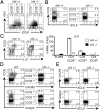Transcription factor IRF4 determines germinal center formation through follicular T-helper cell differentiation
- PMID: 22552227
- PMCID: PMC3365194
- DOI: 10.1073/pnas.1205834109
Transcription factor IRF4 determines germinal center formation through follicular T-helper cell differentiation
Abstract
Follicular T-helper (T(FH)) cells cooperate with GL7(+)CD95(+) germinal center (GC) B cells to induce antibody maturation. Herein, we identify the transcription factor IRF4 as a T-cell intrinsic precondition for T(FH) cell differentiation and GC formation. After immunization with protein or infection with the protozoon Leishmania major, draining lymph nodes (LNs) of IFN-regulatory factor-4 (Irf4(-/-)) mice lacked GCs and GC B cells despite developing normal initial hyperplasia. GCs were also absent in Peyer's patches of naive Irf4(-/-) mice. Accordingly, CD4(+) T cells within the LNs and Peyer's patches failed to express the T(FH) key transcription factor B-cell lymphoma-6 and other T(FH)-related molecules. During chronic leishmaniasis, the draining Irf4(-/-) LNs disappeared because of massive cell death. Adoptive transfer of WT CD4(+) T cells or few L. major primed WT T(FH) cells reconstituted GC formation, GC B-cell differentiation, and LN cell survival. In support of a T-cell intrinsic IRF4 activity, Irf4(-/-) T(FH) cell differentiation was not rescued by close neighborhood to transferred WT T(FH) cells. Together with its known B lineage-specific roles during plasma cell maturation and class switch, our study places IRF4 in the center of antibody production toward T-cell-dependent antigens.
Conflict of interest statement
The authors declare no conflict of interest.
Figures







References
Publication types
MeSH terms
Substances
LinkOut - more resources
Other Literature Sources
Research Materials
Miscellaneous
